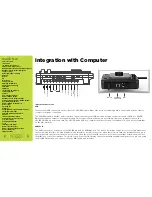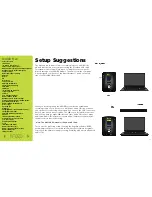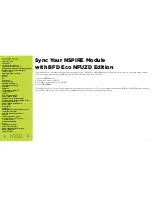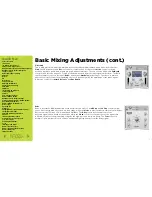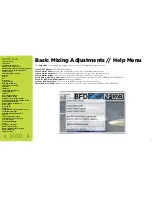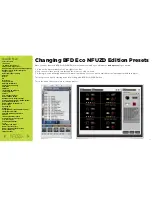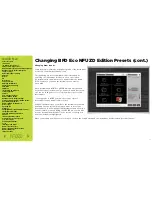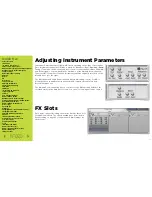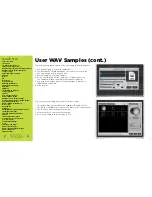
Quick Nav
Table of Contents
Introduction
I/O Module Panel Layouts
Snare and Tom Trigger Zones
NFUZD USB Key (Drive) and Data Management
NSPIRE Series I/O Module Navigation
Trigger Settings
Hi-Hat (HH) Trigger Settings
Kit Menu
Reverb
EQ
Mixer Menu
Saving a UserKit
Adjusting the MIDI Map
Trigger Function Settings
Click Menu
SEQ Menu
Integration with Computer
Setup Suggestions
Sync Key
Auto O
ff
and Sleep Mode
BFD Eco NFUZD Edition
NSPIRE Series I/O Module Settings
Getting Started w/ BFD Eco NFUZD Edition
Basic Mixing Adjustments
BFD Eco NFUZD Edition E
ff
ects
Grooves Page
Options Menu
Help Menu
Changing BFD Eco NFUZD Edition Presets
Changing Drum Sounds
Adjusting Instrument Parameters
FX Slots
Instrument and Mixer Faders
Getting New Professional Sounds
User .wav Samples
Exporting Sound Banks
Loops
Installing Sound Banks
BFD Eco Jukebox Player
BFD Eco Master Output Recording
BFD Eco Mixing Tips
Included Sounds
Basic Mixing Adjustments (cont.)
Delay
This is a classic stereo delay line. As well as
Time
and
Feedback
controls, it features a
Swing
control
for achieving a variety of delay feels, and adjustable
LowCut
and
HighCut
filters in the feedback chain.
The
Sync
control switches between time-based (Sec) and tempo-synced (BPM) delay times. The
Sum
Input
control (available on stereo channels only) sums the left and right inputs to a single mono signal
and feeds one delay line instead of two.
Filter
The Filter e
ff
ect provides simple 1-pole high-pass and low-pass filters. Each filter features power (
LPin
and
HPin
) and frequency (
LPFreq
and
HPFreq
) controls.
Flanger
The Flanger e
ff
ect is a short modulated delay line with feedback to the input. It is used for a sense of
movement and for psychedelic e
ff
ects. The
Freq
control sets the frequency of the Sine LFO used to
modulate the flanger’s delay time, while the
Depth
control adjusts the amount of modulation. The
Pos
(Position) control adds up to 10ms to the flanger’s delay time. The needle display in the Flanger e
ff
ect
represents the delay time modulation. The
Feedback
control adjusts the amount of the processed signal
that is fed back into the input. Higher settings result in a more pronounced flanging e
ff
ect, with settings
over 50% leading to extreme comb filter type e
ff
ects.
The
Mode
button dictates the phase relationship between the input and processed signals. With the
button disabled, the two signals are in phase (resulting in a more pronounced flanging e
ff
ect); with it
enabled, the signals are out of phase. The
Spread
and
Phase
controls are only available on stereo
channels. Spread adjusts the panning of the left and right channel processed signals, while Phase o
ff
sets
the phase of the internal LFOs for the left and right channels.
4 6
Содержание NSPIRE series
Страница 1: ...U S E R M A N U A L O P E N...


